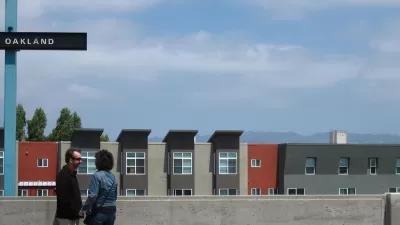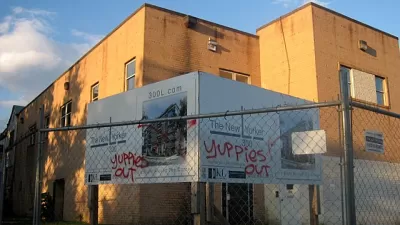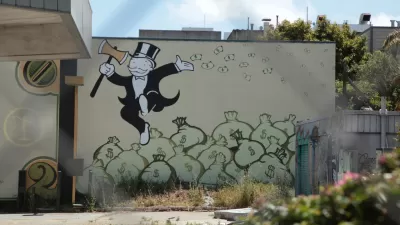Using a mid 20th-century painting as his point of reference, Benjamin Schneider points out that the vast, disruptive changes we often associate with San Francisco are only affecting the city's eastern side.

Urban change isn't equally distributed in San Francisco, Benjamin Schneider writes. "The city that so fascinates out-of-town journalists, tourists, well-compensated newcomers, and, apparently, news consumers around the world is actually only half of San Francisco. The other half [...] continues to be characterized by a suburban landscape and a suburban way of life that has remained basically unchanged for half a century or more."
Schneider argues that the vast changes taking place in neighborhoods like the Mission, SoMa, and Hayes Valley are partly attributable to an "utter lack of change across the west side." He goes on, "Due to outdated zoning laws and an inordinate amount of political power, the wealthiest, least dense neighborhoods have all too successfully shielded themselves from desperately needed new housing and homeless services, leaving a handful of east-side neighborhoods to bear these burdens for the entire city."
"This dynamic—of enormous change in low-income, often non-white neighborhoods close to downtown and virtually no change at all in upper- and upper-middle-class neighborhoods a bit farther out—is in force throughout the Bay Area, California, and major cities across the country."
Schneider concludes that we need a new way to talk about urban change, one that acknowledges the complicity of "rich people militantly preserving their way of life and physical surroundings" when problems like homelessness and displacement affect other parts of the city.
FULL STORY: What we talk about when we talk about urban change

Study: Maui’s Plan to Convert Vacation Rentals to Long-Term Housing Could Cause Nearly $1 Billion Economic Loss
The plan would reduce visitor accommodation by 25,% resulting in 1,900 jobs lost.

Alabama: Trump Terminates Settlements for Black Communities Harmed By Raw Sewage
Trump deemed the landmark civil rights agreement “illegal DEI and environmental justice policy.”

Why Should We Subsidize Public Transportation?
Many public transit agencies face financial stress due to rising costs, declining fare revenue, and declining subsidies. Transit advocates must provide a strong business case for increasing public transit funding.

Paris Bike Boom Leads to Steep Drop in Air Pollution
The French city’s air quality has improved dramatically in the past 20 years, coinciding with a growth in cycling.

Why Housing Costs More to Build in California Than in Texas
Hard costs like labor and materials combined with ‘soft’ costs such as permitting make building in the San Francisco Bay Area almost three times as costly as in Texas cities.

San Diego County Sees a Rise in Urban Coyotes
San Diego County experiences a rise in urban coyotes, as sightings become prevalent throughout its urban neighbourhoods and surrounding areas.
Urban Design for Planners 1: Software Tools
This six-course series explores essential urban design concepts using open source software and equips planners with the tools they need to participate fully in the urban design process.
Planning for Universal Design
Learn the tools for implementing Universal Design in planning regulations.
Smith Gee Studio
Alamo Area Metropolitan Planning Organization
City of Santa Clarita
Institute for Housing and Urban Development Studies (IHS)
City of Grandview
Harvard GSD Executive Education
Toledo-Lucas County Plan Commissions
Salt Lake City
NYU Wagner Graduate School of Public Service





























